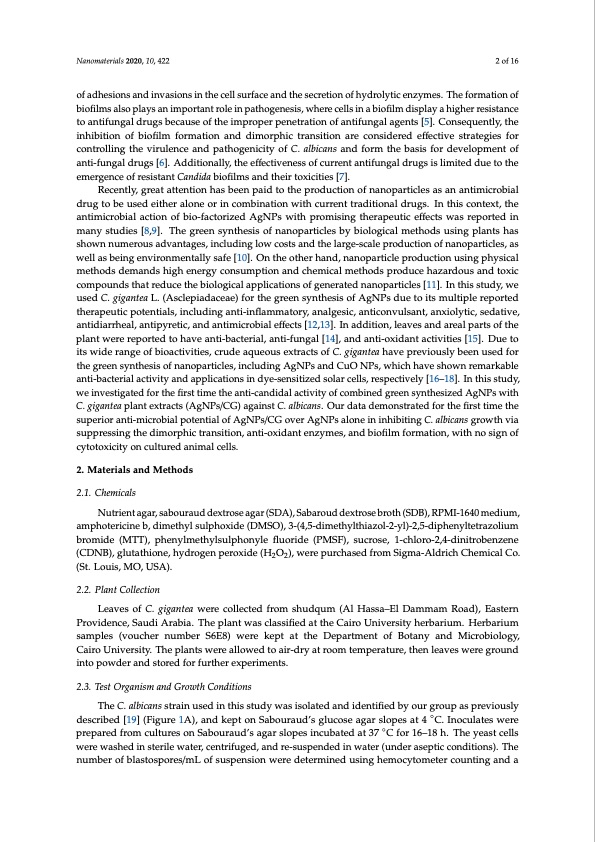
PDF Publication Title:
Text from PDF Page: 002
Nanomaterials 2020, 10, 422 2 of 16 of adhesions and invasions in the cell surface and the secretion of hydrolytic enzymes. The formation of biofilms also plays an important role in pathogenesis, where cells in a biofilm display a higher resistance to antifungal drugs because of the improper penetration of antifungal agents [5]. Consequently, the inhibition of biofilm formation and dimorphic transition are considered effective strategies for controlling the virulence and pathogenicity of C. albicans and form the basis for development of anti-fungal drugs [6]. Additionally, the effectiveness of current antifungal drugs is limited due to the emergence of resistant Candida biofilms and their toxicities [7]. Recently, great attention has been paid to the production of nanoparticles as an antimicrobial drug to be used either alone or in combination with current traditional drugs. In this context, the antimicrobial action of bio-factorized AgNPs with promising therapeutic effects was reported in many studies [8,9]. The green synthesis of nanoparticles by biological methods using plants has shown numerous advantages, including low costs and the large-scale production of nanoparticles, as well as being environmentally safe [10]. On the other hand, nanoparticle production using physical methods demands high energy consumption and chemical methods produce hazardous and toxic compounds that reduce the biological applications of generated nanoparticles [11]. In this study, we used C. gigantea L. (Asclepiadaceae) for the green synthesis of AgNPs due to its multiple reported therapeutic potentials, including anti-inflammatory, analgesic, anticonvulsant, anxiolytic, sedative, antidiarrheal, antipyretic, and antimicrobial effects [12,13]. In addition, leaves and areal parts of the plant were reported to have anti-bacterial, anti-fungal [14], and anti-oxidant activities [15]. Due to its wide range of bioactivities, crude aqueous extracts of C. gigantea have previously been used for the green synthesis of nanoparticles, including AgNPs and CuO NPs, which have shown remarkable anti-bacterial activity and applications in dye-sensitized solar cells, respectively [16–18]. In this study, we investigated for the first time the anti-candidal activity of combined green synthesized AgNPs with C. gigantea plant extracts (AgNPs/CG) against C. albicans. Our data demonstrated for the first time the superior anti-microbial potential of AgNPs/CG over AgNPs alone in inhibiting C. albicans growth via suppressing the dimorphic transition, anti-oxidant enzymes, and biofilm formation, with no sign of cytotoxicity on cultured animal cells. 2. Materials and Methods 2.1. Chemicals Nutrient agar, sabouraud dextrose agar (SDA), Sabaroud dextrose broth (SDB), RPMI-1640 medium, amphotericine b, dimethyl sulphoxide (DMSO), 3-(4,5-dimethylthiazol-2-yl)-2,5-diphenyltetrazolium bromide (MTT), phenylmethylsulphonyle fluoride (PMSF), sucrose, 1-chloro-2,4-dinitrobenzene (CDNB), glutathione, hydrogen peroxide (H2O2), were purchased from Sigma-Aldrich Chemical Co. (St. Louis, MO, USA). 2.2. Plant Collection Leaves of C. gigantea were collected from shudqum (Al Hassa–El Dammam Road), Eastern Providence, Saudi Arabia. The plant was classified at the Cairo University herbarium. Herbarium samples (voucher number S6E8) were kept at the Department of Botany and Microbiology, Cairo University. The plants were allowed to air-dry at room temperature, then leaves were ground into powder and stored for further experiments. 2.3. Test Organism and Growth Conditions The C. albicans strain used in this study was isolated and identified by our group as previously described [19] (Figure 1A), and kept on Sabouraud’s glucose agar slopes at 4 ◦C. Inoculates were prepared from cultures on Sabouraud’s agar slopes incubated at 37 ◦C for 16–18 h. The yeast cells were washed in sterile water, centrifuged, and re-suspended in water (under aseptic conditions). The number of blastospores/mL of suspension were determined using hemocytometer counting and aPDF Image | Inhibition of Candidiasis Calotropis Silver Nanoparticles

PDF Search Title:
Inhibition of Candidiasis Calotropis Silver NanoparticlesOriginal File Name Searched:
nanomaterials-10-00422-v3.pdfDIY PDF Search: Google It | Yahoo | Bing
Turbine and System Plans CAD CAM: Special for this month, any plans are $10,000 for complete Cad/Cam blueprints. License is for one build. Try before you buy a production license. More Info
Waste Heat Power Technology: Organic Rankine Cycle uses waste heat to make electricity, shaft horsepower and cooling. More Info
All Turbine and System Products: Infinity Turbine ORD systems, turbine generator sets, build plans and more to use your waste heat from 30C to 100C. More Info
CO2 Phase Change Demonstrator: CO2 goes supercritical at 30 C. This is a experimental platform which you can use to demonstrate phase change with low heat. Includes integration area for small CO2 turbine, static generator, and more. This can also be used for a GTL Gas to Liquids experimental platform. More Info
Introducing the Infinity Turbine Products Infinity Turbine develops and builds systems for making power from waste heat. It also is working on innovative strategies for storing, making, and deploying energy. More Info
Need Strategy? Use our Consulting and analyst services Infinity Turbine LLC is pleased to announce its consulting and analyst services. We have worked in the renewable energy industry as a researcher, developing sales and markets, along with may inventions and innovations. More Info
Made in USA with Global Energy Millennial Web Engine These pages were made with the Global Energy Web PDF Engine using Filemaker (Claris) software.
Infinity Turbine Developing Spinning Disc Reactor SDR or Spinning Disc Reactors reduce processing time for liquid production of Silver Nanoparticles.
| CONTACT TEL: 608-238-6001 Email: greg@infinityturbine.com | RSS | AMP |